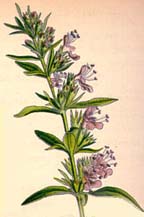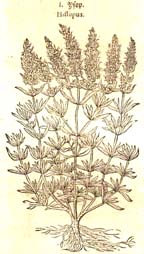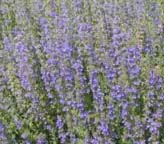 Hyssopus
officinalis Hyssopus
officinalis
Hyssop
This aromatic native of southern Europe was spread throughout
the continent by the Roman army. This magick herb is also native to central Asia as far
as the Western Himalayas. Its camphorous minty smell is great in potpourri
and has long associated it with purification and cleanliness. Because of
its effectiveness at purification, it is considered a Jupiter
herb, even though it is not especially tall or imposing as a plant (Agrippa
considers it a Moon plant). This magick
herb is still a part of purification in
ceremonial magick (see Book
2, Ch. 11 of Key of Solomon). Its protective nature
is exemplified in the Hebrew Bible; hyssop branches were used as brushes
to smear door lintels with lamb's blood so that the Angel of Death would
pass by those homes (although some people believe that the biblical hyssop
was actually a variety of oregano). John Baptist Porta's seventeenth-century
book on natural magick cites hyssop as helpful in turning away the evil
eye, and in Sicily it is still used this way. In Europe, sprigs are hung
up around the house to keep away evil and negativity, and contemporary Pagans
sprinkle an infusion of hyssop around the house or person for protection.
Top
 Herbalism.
This bitter herb is considered a good cleanser of the body, especially the
lungs. In the "Dark" Ages, it was strewn in the sickroom to fight
illness and in the kitchen to combat cooking odors. A bag of hyssop in the
bath will soothe itchy skin. Hyssop flower essence helps in dealing with
unnecessary guilt, shame, fear of being judged, perfectionism, and damaged
self-esteem; it helps undo irrational self-blame and eases animals that
have been disciplined harshly in the past. Since Elizabethan times, an infusion
of the chopped leaves has been used as a wash to get rid of headlice--especially
helpful for people whose kids keep bringing these critters home from school
with them. Head washing with an infusion and nitpicking should continue for several days.
A gargle of hyssop and sage sweetened with honey is an old treatment for
sore throats, and hyssop tea works as an expectorant for asthma and coughs.
A poultice of the leaves kills the pain of bruises and prevents black-and-blue
marks. Like many aromatic herbs, hyssop has antiviral properties, and it
shows particular promise against HIV and herpes. Tops and flowers are high
in iodine, so avoid them if you have problems with that element, as in goiter.
This herb goes into liquers like Benedictine and Chartreuse, and the flowers
make a nice edible garnish. Top
Herbalism.
This bitter herb is considered a good cleanser of the body, especially the
lungs. In the "Dark" Ages, it was strewn in the sickroom to fight
illness and in the kitchen to combat cooking odors. A bag of hyssop in the
bath will soothe itchy skin. Hyssop flower essence helps in dealing with
unnecessary guilt, shame, fear of being judged, perfectionism, and damaged
self-esteem; it helps undo irrational self-blame and eases animals that
have been disciplined harshly in the past. Since Elizabethan times, an infusion
of the chopped leaves has been used as a wash to get rid of headlice--especially
helpful for people whose kids keep bringing these critters home from school
with them. Head washing with an infusion and nitpicking should continue for several days.
A gargle of hyssop and sage sweetened with honey is an old treatment for
sore throats, and hyssop tea works as an expectorant for asthma and coughs.
A poultice of the leaves kills the pain of bruises and prevents black-and-blue
marks. Like many aromatic herbs, hyssop has antiviral properties, and it
shows particular promise against HIV and herpes. Tops and flowers are high
in iodine, so avoid them if you have problems with that element, as in goiter.
This herb goes into liquers like Benedictine and Chartreuse, and the flowers
make a nice edible garnish. Top
 In
the Garden. Hyssop is wonderful for lining paths,
where brushing against it will release its aroma, and interplanting it with
members of the cabbage family will help keep cabbage moths and aphids away.
It's a wonderful to medieval or cottage gardens. This perennial herb grows throughout the temperate areas of North America
(zones 3-9). It gets 18-24 inches/60 cm high and forms a small shrub with
blue, pink, or white flowers beloved by bees and hummingbirds. The flowers
appear on the square stems in late summer and once it is established, start
blooming in early spring. The whole plant is aromatic. Top In
the Garden. Hyssop is wonderful for lining paths,
where brushing against it will release its aroma, and interplanting it with
members of the cabbage family will help keep cabbage moths and aphids away.
It's a wonderful to medieval or cottage gardens. This perennial herb grows throughout the temperate areas of North America
(zones 3-9). It gets 18-24 inches/60 cm high and forms a small shrub with
blue, pink, or white flowers beloved by bees and hummingbirds. The flowers
appear on the square stems in late summer and once it is established, start
blooming in early spring. The whole plant is aromatic. Top
 How
to grow hyssop: The fastest way to germinate this
seed is with the baggie method. Wet a paper towel and wring out.
"Sow" the seeds in 1/4 of the paper towel and then fold
it up into eighths, pressing it gently. Put in a cheap baggie and
don't close the top. Leave in indirect light at room temperature,
and check for germination after a couple days. Seeds germinate within
a week. Then tear up the paper towel into pieces and gently press
them seed side up into your potting medium or jiffy pellet. Grow
on and harden off, then transplant outside. Or you can follow more
traditional methods and Barely cover seeds to germinate in 3-4 weeks at room temperature.
Seeds will germinate slowly.
Harden off and transplant to full sun or partial shade. Growers usually
start this 10 weeks before the last frost to have a jump on the
season. Hyssop can also be grown in pots. Once
established, it can be propagated by root division in fall or by rooting cuttings
in the summer. On or close to Full Moon, harvest leaves before the plant flowers
in the morning after the dew is off. Harvest flowers when they are almost completely
open. Dry upside down in bunches, then strip off leaves and flowers and store
in airtight container away from light. Prune after flowering to make a more
compact plant, & mulch for winter in coldest climates. General
growing info Top How
to grow hyssop: The fastest way to germinate this
seed is with the baggie method. Wet a paper towel and wring out.
"Sow" the seeds in 1/4 of the paper towel and then fold
it up into eighths, pressing it gently. Put in a cheap baggie and
don't close the top. Leave in indirect light at room temperature,
and check for germination after a couple days. Seeds germinate within
a week. Then tear up the paper towel into pieces and gently press
them seed side up into your potting medium or jiffy pellet. Grow
on and harden off, then transplant outside. Or you can follow more
traditional methods and Barely cover seeds to germinate in 3-4 weeks at room temperature.
Seeds will germinate slowly.
Harden off and transplant to full sun or partial shade. Growers usually
start this 10 weeks before the last frost to have a jump on the
season. Hyssop can also be grown in pots. Once
established, it can be propagated by root division in fall or by rooting cuttings
in the summer. On or close to Full Moon, harvest leaves before the plant flowers
in the morning after the dew is off. Harvest flowers when they are almost completely
open. Dry upside down in bunches, then strip off leaves and flowers and store
in airtight container away from light. Prune after flowering to make a more
compact plant, & mulch for winter in coldest climates. General
growing info Top
|
Hyssopus officinalis
Hyssop (mixture of blue,
pink, and white flowers)
300 seeds $3.75
|